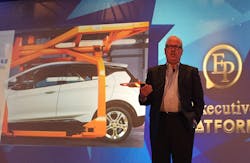The automotive industry is not new to the world of robotics. Since the 1960s, car manufacturers have pioneered the use of industrial robots, and automotive-related orders of industrial robotics really took off in the 1980s. But automotive manufacturers are beginning to embrace a whole new world of robotics—for tasks beyond welding and painting—that includes collaborative robots, drones, exoskeletons and other advanced technologies.
Though collaborative robots (cobots) have gained more of a foothold in industries outside the heavy industrial manufacturing realm, they have become a “fundamental game changer” on the automotive factory floor, according to Dan Grieshaber, global director of manufacturing engineering integration at General Motors.
“We’ve had robots in our factories since the ‘80s. Robots are not new to us. Almost all our welding is done robotically,” Grieshaber said. “But when we get to the assembly side of things, it’s still quite people-intensive.”
Because cobots will stop safely if they come in contact with a human, this opens up several applications for use as an assistant directly on an assembly line, Grieshaber commented. “Maybe they’re helping me with a task or delivering materials to me. Or maybe they’re assisting with something that’s quite heavy,” he said. “I can do that without fences or any other safety devices.”
Detailing the carmaker’s transition to a smart factory at this week’s North American Manufacturing Excellence Summit (NAMES) near Chicago, Grieshaber marveled at the advances that GM has been able to take advantage of.
As another example, he showed off the drones the company is using to inspect a sand delivery pipe inside one of the company’s casting plants. Towering high above the factory floor, pipe inspection is inherently dangerous, he noted. Instead, a drone flies around inside a cage, tracks the pipe, and can spot potential problem areas like cracks. “We send the drone in, have it capture the environment, identify what work needs to get done, and then we’ll send in an operator with a specific job to do.” This significantly cuts down on the amount of time a human must spend in that and other dangerous environments, he added. “The person is only working where they need to work.”
GM is using exoskeletons—essentially wearable robots—for repetitive operations in manufacturing. Typically in car manufacturing, a worker might need to perform a task within 45 seconds before the next car comes along. “Our workforce is getting older, so we all need a little help,” Grieshaber noted. “An exoskeleton can actually support my body and distribute that load. It’s helping me stay safer, but also helping me perform my job in an easier way.”
Grieshaber talked about the robotic glove technology that GM developed along with NASA and is still being used on the International Space Station. At GM, workers are using the RoboGlove to add strength and grip to the human hand. “It’s a glove driven by a mechanical delivery system that you wear on your back like a knapsack, and it increases your grip strength,” Grieshaber explained. “As you grip, it’s aiding you with more assistance. It really greatly reduces fatigue.”
Grieshaber described one worker who had been taking three Advil with lunch every day because of the pain caused by the grip repetition. “The first day he put this on, he got to lunch and said it was like he hadn’t even worked,” he said.
Just as autonomous vehicle technology is making its way to public streets, Grieshaber predicted a time when factories would be able to operate completely autonomous vehicles rather than just the guided vehicles typically used today. “Think of a Waze app running in your factories, and if these vehicles were really autonomous—if it got to where it needed to be just in time, and it figured its own routes,” he said, describing a situation in which a vehicle figured out a different path based on the time of day so that it would encounter the fewest number of people along the way. “Why can’t we do this? Would you lay out your factory differently?”
GM is also taking advantage of technological advances with its more standard industrial robots—pursing zero-downtime technology with strategic partner Fanuc. “Every day, we’re able to pull performance data from our robots, [and] transmit it securely to Fanuc to run analytics,” Grieshaber said. “Against their deep knowledge of their equipment, they give us back predictive maintenance—they tell us what’s potentially coming so we can schedule maintenance.”
This works in contrast to replacing parts every 1,000 hours just because the manual says to, or waiting until a system goes down and then scrambling to get it back online, or having a fleet of spares in-house to be prepared for failures," Grieshaber said. “These are all non-productive activities that has our capital tied up,” he added. “We’re rethinking how we maintain our equipment.”
Beyond robotics technologies, Grieshaber also pointed to GM’s use of other technologies like 3D printing and rapid prototyping, virtual operator training, smart wearables and machine vision inspection. But he also emphasized that this is not technology for technology’s sake.
“In general, we’re not starting with the technology and then looking at how to infuse it in our business. In general, we’re starting with the business model,” Grieshaber said. “But new technologies will get you thinking differently and challenge your business model.”
The GM Smart Factory is really about a connected manufacturing environment, Grieshaber added. “It’s very much a business transaction play that’s enabled by technology,” he said, warning, “If you don’t do it, somebody else is going to. They can obsolete you overnight. The question isn’t should you do this; the question is when’s it going to happen.”
Leaders relevant to this article:

